Monuments
(Classified UNESCO World Heritage Site)
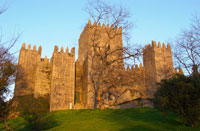
Castle The castle was built in the 10th century by the Countess Mumadona Dias to protect the local population, and soon afterward the town sprang up around these defenses.
|
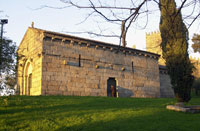
Chapel of St. Michael (Capela de S. Miguel) Built in the 12th century in the Romanesque style, the Chapel of St. Michael is thought to be place where D. Afonso Henriques was baptized. The floor of the chapel is covered with large burial stones of knights who aided in the fight for nationhood.
|
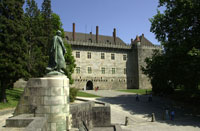
Palace of the Dukes of Bragança (Paço dos Duques de Bragança) The Paço dos Duques de Bragança, built in the 15th century by the then-future duke Dom Afonso, shows elements of architectural styles common in the great manor houses and palaces of northern Europe. In the 19th century, it served as a military barracks. In the mid-20th century, after a period of disuse and abandonment, the palace was renovated and saw new life as a museum displaying items from the 17th and 18th centuries. From its various collections are pieces that document Portuguese contributions during the Age of Discoveries, while others narrate events in the Conquest of North Africa. Also in the holdings are a collection of arms from the 15th to the 19th centuries and furniture from the Post-Discoveries era.
|
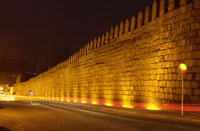
City Walls of Guimarães (Muralhas da Cidade) The current walls of the city are remnants of those that encircled Guimarães during the reign of Kings Dom Dinis and Dom João I, in the 14th and 15th centuries. Some historians put the walls as originating in the 10th century.
|
|
Church of Nossa Senhora da Oliveira The present-day church was built on the order of King João I, in fulfillment of a promise he made to the Blessed Virgin Mary at the Battle of Aljubarrota.
|
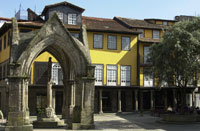
Salado Monument This monument was built in the 15th century by Dom Afonso IV to commemorate the victory at the Battle of Salado.
|
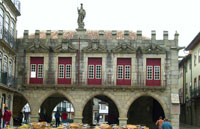
Old Town Council Chambers (Antigos Paços do Concelho) This hall, the Antigos Paços do Concelho, traces its origins to a building from the 14th century.
|
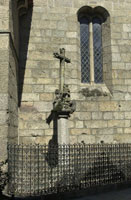
Shrine of Our Lady of Guia (Cruzeiro Nossa Senhora da Guia) This small shrine, the Cruzeiro Nossa Senhora da Guia is also known as the Senhora da Piedade, or Our Lady of Sorrows, because of the Pietà depicted there. Its original location is unknown but it can currently be seen next to the Oliveira Church behind an iron grate. |
|
HISTORIC CITY CENTRE – Tampão Area |

Monument of King D. João I Some historians believe that this monument was erected by King D. João I in the 14th century to commemorate the victory at the Battle of Aljubarrota. |

Cloister of the Church of São Domingos Constructed in the 14th century, today it is part of the Archaeology Museum of the Martins Sarmento Society. |
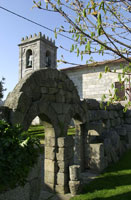
Chapel of St. Torcato A building with roots in the Visigoth era, its features are more Romanesque (12th century), yet its interior bears traces of pre-Romanesque. |
|
Bridge at Serves This stone structure with four rounded arches was built in the Middle Ages.
|
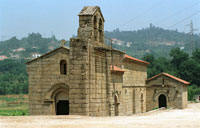
Church of Serzedelo The cluster of buildings that make up the Church of Santa Cristina in Serzedelo was an important spot in the Low Middle Ages in the Between-Douro-and-Minho region of Portugal. Over the centuries a Romanesque church was built with a gothic narthex, a bell tower from the 13the century and a funerary chapel that today serves as a sacristy.
|
Church of St. Martinho at Candoso
This simple country church in the village of Candoso, like so many which dotted the Between-Douro-and-Minho region, dates from time of the founding of the Portuguese Nation. Romanesque features from the 13th century, such as a triumphal arch, double rounded arches and some geometric decorations, can be found here.
Candoso S. Martinho
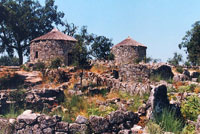
Citânia de Briteiros Archaeological ruins of a primitive human settlement are testament of the existence of the pre-Roman people known as the “Castro culture” in northeastern Portugal. Artifacts taken from the site can be visited at the Museum of the Martins Sarmento Society in Guimarães.
|
Citânia de Sabroso
These ruins, not very far from the Briteiros site, show signs of human settlement from the Iron Age. Vestiges of a single defensive wall some three to five metres in height and about 4.5 metres in thickness have been found. Inside the settlement approximately 38 individual dwellings have been found.
Monte do Couto de Sabroso – Briteiros S. Lourenço
The Taipas Stone (Lápide das Taipas)
The Lápide das Taipas is one of the few examples in the northeastern Iberian Peninsula of a monument that survives to this day in praise of the Roman emperor Trajan (1st and 2nd centuries). It can be visited near the parish church of Caldelas.
Rua Trajano Augusto – Caldelas
Braga – Guimarães Road Marker
On the ancient road that linked these cities were two military markers that are now housed in the Archaeological Museum of the Martins Sarmento Society.


